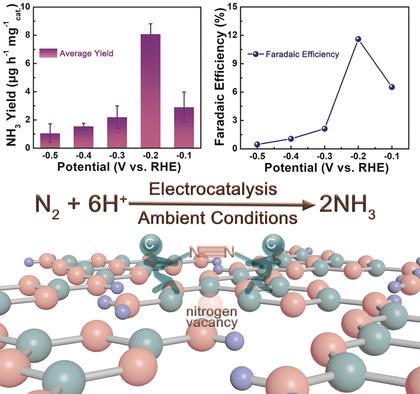当前位置:
X-MOL 学术
›
Angew. Chem. Int. Ed.
›
论文详情
Our official English website, www.x-mol.net, welcomes your
feedback! (Note: you will need to create a separate account there.)
Defect Engineering Metal‐Free Polymeric Carbon Nitride Electrocatalyst for Effective Nitrogen Fixation under Ambient Conditions
Angewandte Chemie International Edition ( IF 16.1 ) Pub Date : 2018-07-15 , DOI: 10.1002/anie.201806386 Chade Lv 1, 2 , Yumin Qian 1 , Chunshuang Yan 1, 2 , Yu Ding 1 , Yuanyue Liu 1 , Gang Chen 2 , Guihua Yu 1
Angewandte Chemie International Edition ( IF 16.1 ) Pub Date : 2018-07-15 , DOI: 10.1002/anie.201806386 Chade Lv 1, 2 , Yumin Qian 1 , Chunshuang Yan 1, 2 , Yu Ding 1 , Yuanyue Liu 1 , Gang Chen 2 , Guihua Yu 1
Affiliation

|
Electrocatalytic nitrogen reduction reaction (NRR) under ambient conditions provides an intriguing picture for the conversion of N2 into NH3. However, electrocatalytic NRR mainly relies on metal‐based catalysts, and it remains a grand challenge in enabling effective N2 activation on metal‐free catalysts. Here we report a defect engineering strategy to realize effective NRR performance (NH3 yield: 8.09 μg h−1 mg−1cat., Faradaic efficiency: 11.59 %) on metal‐free polymeric carbon nitride (PCN) catalyst. Illustrated by density functional theory calculations, dinitrogen molecule can be chemisorbed on as‐engineered nitrogen vacancies of PCN through constructing a dinuclear end‐on bound structure for spatial electron transfer. Furthermore, the N−N bond length of adsorbed N2 increases dramatically, which corresponds to “strong activation” system to reduce N2 into NH3. This work also highlights the significance of defect engineering for improving electrocatalysts with weak N2 adsorption and activation ability.
中文翻译:

缺陷工程无金属聚合氮化碳电催化剂,可在环境条件下有效固氮
在环境条件下的电催化氮还原反应(NRR)为将N 2转化为NH 3提供了有趣的画面。但是,电催化NRR主要依赖于金属基催化剂,在无金属催化剂上实现有效的N 2活化方面仍然是一个巨大的挑战。在这里,我们报告了一种缺陷工程策略,以实现有效的NRR性能(NH 3产量:8.09μgh -1 mg -1 cat。,法拉第效率:11.59%)在不含金属的聚合氮化碳(PCN)催化剂上。通过密度泛函理论计算可以说明,通过构建用于空间电子转移的双核末端键合结构,可以将二氮分子化学吸附在PCN的工程化氮空位上。此外,被吸附的N 2的N-N键长显着增加,这对应于“强活化”系统将N 2还原为NH 3。这项工作还强调了缺陷工程对改善具有弱N 2吸附和活化能力的电催化剂的重要性。
更新日期:2018-07-15
中文翻译:

缺陷工程无金属聚合氮化碳电催化剂,可在环境条件下有效固氮
在环境条件下的电催化氮还原反应(NRR)为将N 2转化为NH 3提供了有趣的画面。但是,电催化NRR主要依赖于金属基催化剂,在无金属催化剂上实现有效的N 2活化方面仍然是一个巨大的挑战。在这里,我们报告了一种缺陷工程策略,以实现有效的NRR性能(NH 3产量:8.09μgh -1 mg -1 cat。,法拉第效率:11.59%)在不含金属的聚合氮化碳(PCN)催化剂上。通过密度泛函理论计算可以说明,通过构建用于空间电子转移的双核末端键合结构,可以将二氮分子化学吸附在PCN的工程化氮空位上。此外,被吸附的N 2的N-N键长显着增加,这对应于“强活化”系统将N 2还原为NH 3。这项工作还强调了缺陷工程对改善具有弱N 2吸附和活化能力的电催化剂的重要性。











































 京公网安备 11010802027423号
京公网安备 11010802027423号